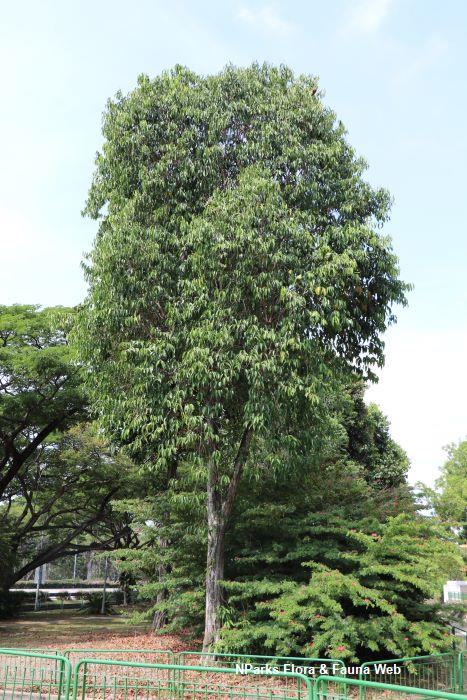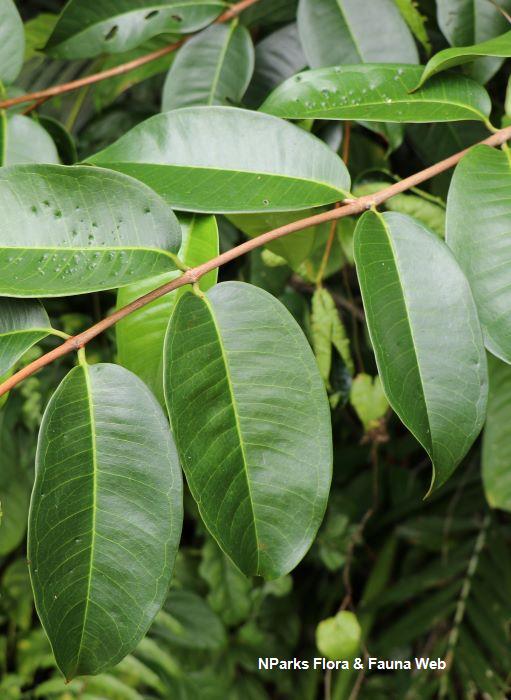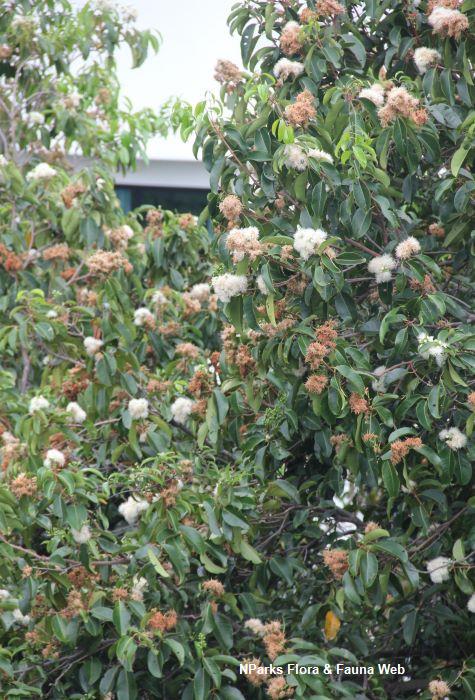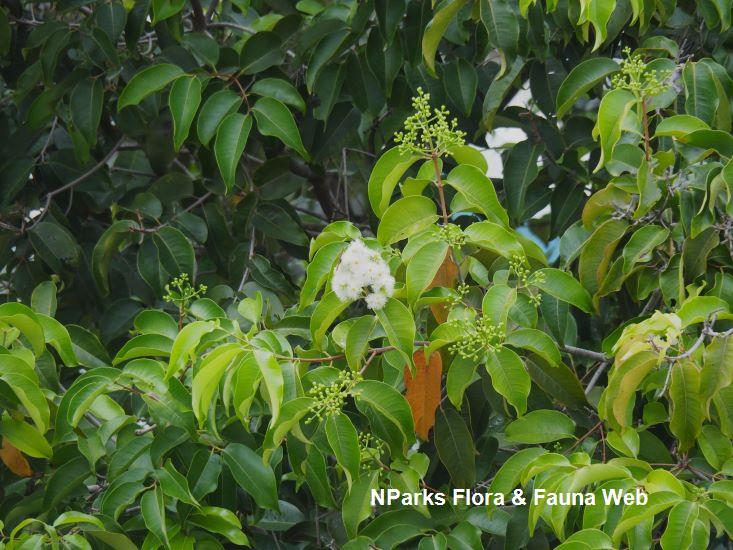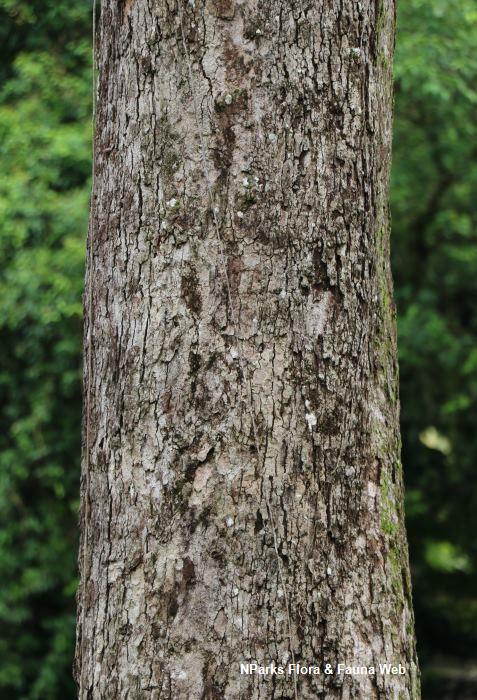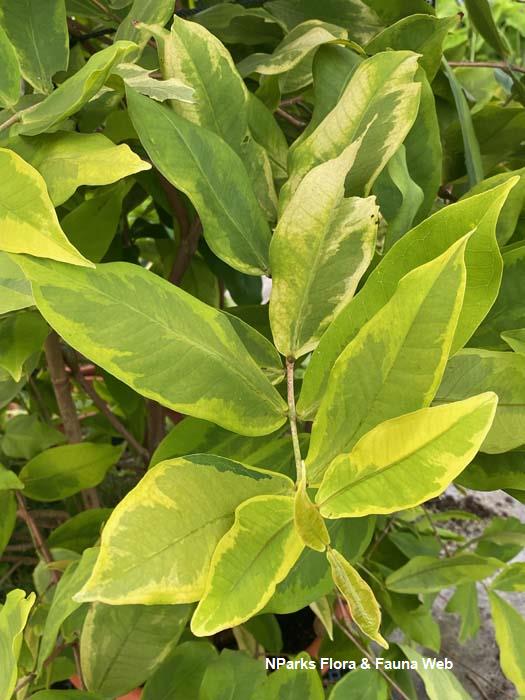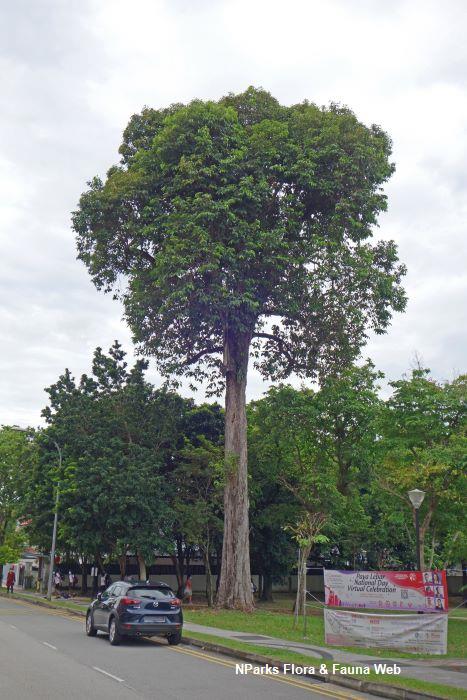
Back
Syzygium grande (Wight) Walp.
| Family Name: | Myrtaceae |
| Synonyms: | Eugenia grandis Wight |
| Common Name: | Sea Apple, Jambu Laut, Kilat Jambu, Jambu Air Laut, Jambu Ayer Laut, Jambu Jembah, Jembah, Kerian Acheh, Kerian Ayer, Keriang Batu, Ubah, 大蒲桃, 海蒲桃 |
Name
Classifications and Characteristics
| Plant Division | Angiosperms (Flowering Seed Plants) (Dicotyledon) |
|---|---|
| Plant Growth Form | Tree (Big (>30m)) |
| Lifespan (in Singapore) | Perennial |
| Mode of Nutrition | Autotrophic |
| Plant Shape | Columnar, Irregular |
| Maximum Height | 25 m to 45 m |
Biogeography
| Native Distribution | India, Sri Lanka, Myanmar, Vietnam, Laos, Thailand, Malaysia, Singapore, Brunei, and Indonesia |
|---|---|
| Native Habitat | Terrestrial (Coastal Forest, Secondary Rainforest) |
| Preferred Climate Zone | Tropical |
| Local Conservation Status | Native to Singapore (Least Concern (LC)) |
Description and Ethnobotany
| Growth Form | It is a tree with oblong to irregular crown, which can grow up to 45 m tall, and 75 cm diameter. |
|---|---|
| Foliage | It has opposite, stalked leaves that are leathery, broadly elliptic, 9.4–25 cm long by 4–13 cm wide, darker green above, lighter green below, and each has a down-turned leaf tip, 2 veins running parallel to the leaf margin, and 9–16 pairs of side veins. |
| Flowers | It produces bisexual flowers that are white, fragrant, 2.5–3.8 cm across, and are found in 4–14 cm long flower clusters located at the axils of its leaves, or ends of its branches. |
| Fruit | It produces fleshy fruits that are round, elliptic or oblong elliptic, 1.5–4 cm long by 1.3–3 cm wide, green when ripe, and each contains 1 seed. Each seed is round or flattened, up to 2.5 cm across. |
| Others - Plant Morphology | Synchronous flowering can be observed at the onset of wet spell. Intensity of flowering is more obvious, if the wet spell comes after a long dry spell. Flowers large, compact, white with puffy appearance; mushy fragrance often attracts birds, bees and butterflies. Spent blooms persistence and brown, often giving the trees an untidy appearance.Fruits round to oblong, with green leathery rind when ripe; edible, often eaten and dispersed by bats. Tree used to be planted closely, as a firebreak, at the edge of lalang-infested wasteland because 'live' wood of this tree does not burn easily. |
| Habitat | It grows in coastal forest, and on sandy and rocky coasts. In Singapore, it is planted as roadside trees, and can be found in secondary forests near coasts. |
| Associated Fauna | Its flowers produced nectars, and are probably pollinated by bats. The nectar can also attract insects like butterflies and birds. Bats would also eat its fruits and help dispersed its seeds. It is also the host plant of the moth, Parasa lepida. |
| Cultivation | It can be propagated by seeds and cuttings. |
| Etymology | Greek syzygos, joined, referring to the paired leaves of this species; Latin grande, great. |
| Ethnobotanical Uses | Timber & Products: The wood produced by this tree is classified under the medium hard wood group. In our region, a general trade name ‘Kelat’ is given to timber produced from Syzygium trees. |
Landscaping Features
| Desirable Plant Features | Fragrant (Flowers) (Day), Ornamental Flowers |
|---|---|
| Landscape Uses | General, Coastal, Parks & Gardens, Shade Providing Tree / Palm |
Fauna, Pollination and Dispersal
| Fauna Pollination Dispersal Associated Fauna | Bird-Attracting, Butterfly-Attracting, Caterpillar Moth Food Plant |
|---|---|
| Pollination Method(s) | Biotic (Fauna) (Insects (Bee), Insects (Butterfly, Moth), Vertebrates (Bird)) |
| Seed or Spore Dispersal | Abiotic |
Plant Care and Propagation
| Light Preference | Full Sun |
|---|---|
| Water Preference | Moderate Water |
| Plant Growth Rate | Fast to Moderate |
| Rootzone Tolerance | Saline Soils / Salt Spray, Moist Soils, Well-Drained Soils, Easy to Grow |
| Maintenance Requirements | Low |
| Propagation Method | Seed, Stem Cutting |
| Planting Distance | 12 m |
Foliar
| Foliage Retention | Evergreen |
|---|---|
| Mature Foliage Colour(s) | Green |
| Mature Foliage Texture(s) | Glossy / Shiny, Thick, Leathery |
| Prominent Young Flush Colour(s) | Green - Light Green |
| Young Flush Texture(s) | Leathery |
| Foliar Type | Simple / Unifoliate |
| Foliar Arrangement Along Stem | Opposite |
| Foliar Attachment to Stem | Petiolate |
| Foliar Shape(s) | Non-Palm Foliage (Elliptical) |
| Foliar Venation | Pinnate / Net |
| Foliar Margin | Entire |
| Foliar Apex - Tip | Mucronate |
| Foliar Base | Rounded / Obtuse |
| Leaf Area Index (LAI) for Green Plot Ratio | 3.0 (Tree - Intermediate Canopy) |
Non - Foliar and Storage
| Trunk Type (Non Palm) | Woody |
|---|---|
| Mature Bark Texture | Scaly |
| Root Type | Underground (Tap Root, Fibrous Root), Aboveground (Buttress Root) |
Floral (Angiosperm)
| Flower & Plant Sexuality | Bisexual Flowers |
| Flower Colour(s) | Cream / Off-White, White |
|---|---|
| Flower Grouping | Cluster / Inflorescence |
| Inflorescence Type | Panicle |
| Flowering Opening Time | Daytime |
| Flower Lifespan on Plant | Several Days |
| Flowering Habit | Polycarpic |
| Flowering Period Remarks | Usually during at the onset of rainy spell |
Fruit, Seed and Spore
| Mature Fruit Colour(s) | Green |
|---|---|
| Mature Fruit Texture(s) | Leathery |
| Fruit Classification | Simple Fruit |
| Fruit Type |
Image Repository
Others
| Master ID | 1867 |
|---|---|
| Species ID | 3160 |
| Flora Disclaimer | The information in this website has been compiled from reliable sources, such as reference works on medicinal plants. It is not a substitute for medical advice or treatment and NParks does not purport to provide any medical advice. Readers should always consult his/her physician before using or consuming a plant for medicinal purposes. |

